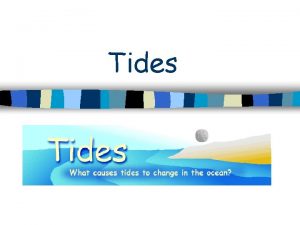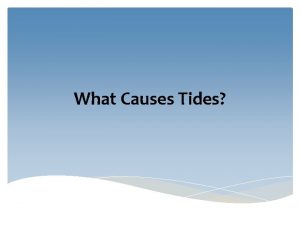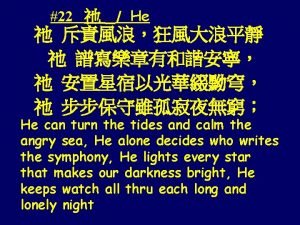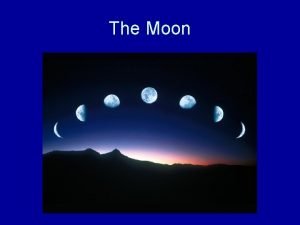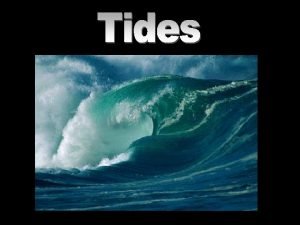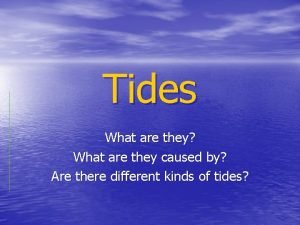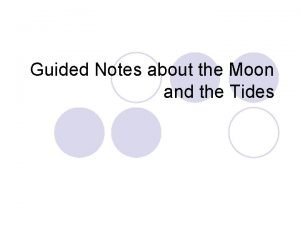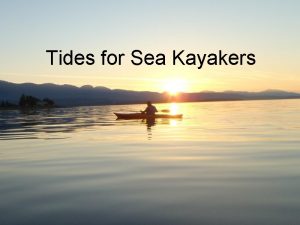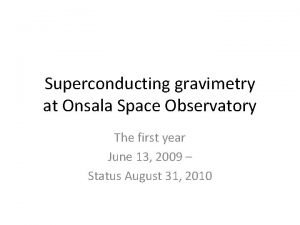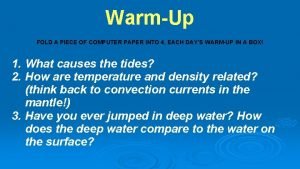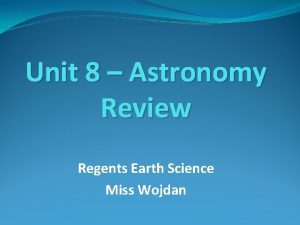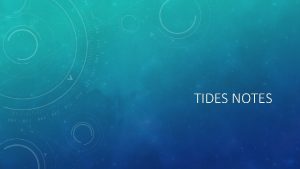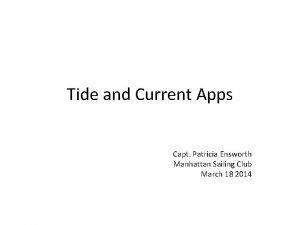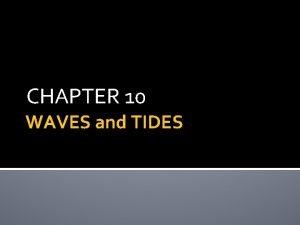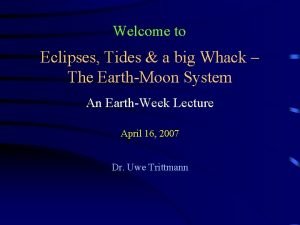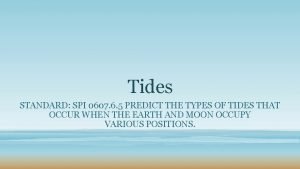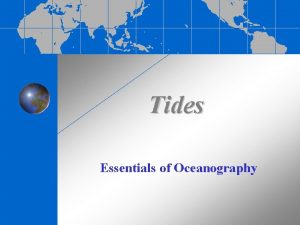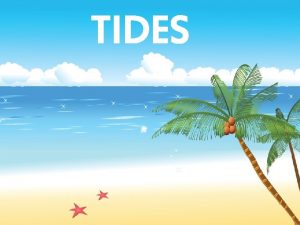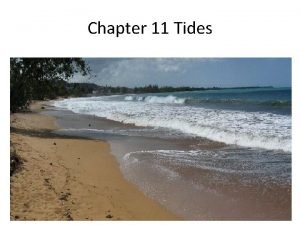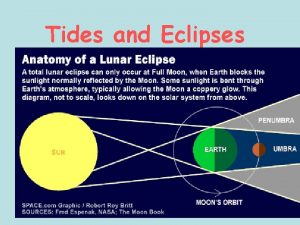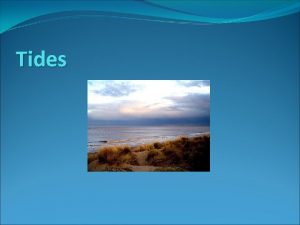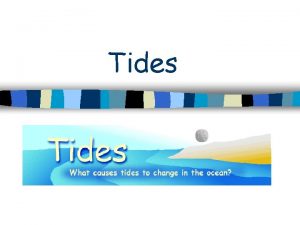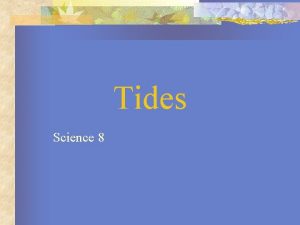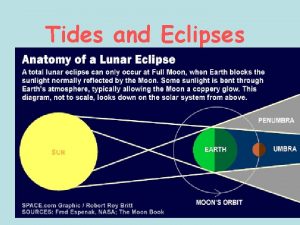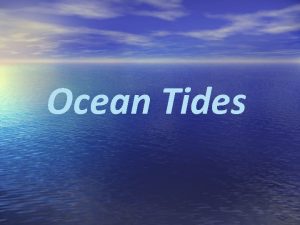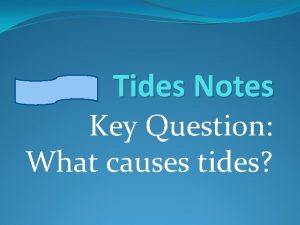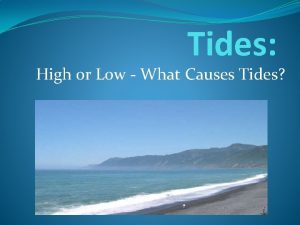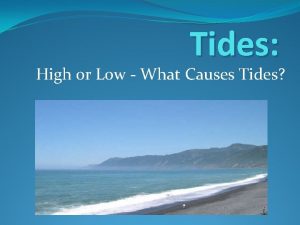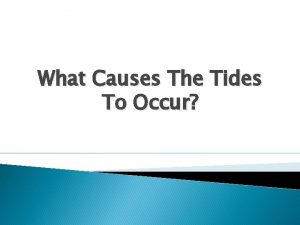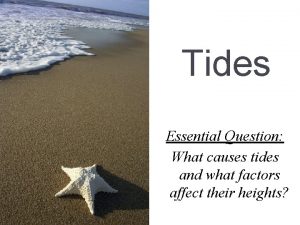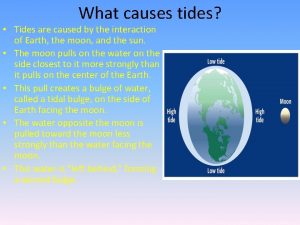Tides I What are Tides II Causes of


























- Slides: 26

Tides I. What are Tides? II. Causes of Tides III. Tidal Variations IV. Lunar Day and Frequency of Tides V. Monitoring Tides Wikimedia Foxy. Orange [CC BY-SA 3. 0

Tides are not explicitly included in the NGSS Performance Expectations. From the NGSS Framework (M. S. Space Science): “There is a strong emphasis on a systems approach, using models of the solar system to explain astronomical and other observations of the cyclic patterns of eclipses, tides, and seasons. ” From the NGSS Crosscutting Concepts: Observed patterns in nature guide organization and classification and prompt questions about relationships and causes underlying them. For Elementary School: • Similarities and differences in patterns can be used to sort, classify, communicate and analyze simple rates of change for natural phenomena and designed products. • Patterns of change can be used to make predictions • Patterns can be used as evidence to support an explanation. For Middle School: • Graphs, charts, and images can be used to identify patterns in data. • Patterns can be used to identify cause-and-effect relationships. The topic of tides have an important connection to global change since spring tides and king tides are causing coastal flooding as sea level has been rising.

I. What are Tides? Tides are one of the most reliable phenomena on Earth - they occur on a regular and predictable cycle. Along with death and taxes, tides are a certainty of life. Tides are apparent changes in local sea level that are the result of long-period waves that move through the oceans. Photos of low and high tide on the coast of the Bay of Fundy in Canada. Samuel Wantman / Wikimedia Commons. Licensed under CC BY-SA 3. 0 via Commons

When the highest part of the tide (crest) reaches the coast, high tide occurs. Low tide occurs when the lowest part of the wave, or its trough reaches the coast. The difference in height between the high tide and the low tide is called the tidal range.

A tidal current is the horizontal movement of water that accompanies the rising and falling of the tide. The incoming tide along the coast and into the bays and estuaries is called a flood current. The outgoing tidal current is called an ebb current. Tidal currents are particularly important in regions like the S. F. Bay.

II. Causes of Tides Two bulges of water occur on opposite sides of the Earth due to the gravitational influence of the Moon - one that roughly faces the Moon and another on the opposite side of the Earth. Since the Moon orbits the Earth slower than the Earth rotates on its axis, the Earth rotates in and out of the tidal bulges. Most coastlines experience two high tides and two low tides about each day. A’ A NOT TO SCALE! High tides are commonly unequal in height due to the axial angle of the Earth’s rotation. For example, the location on the Earth at A has a fairly large high tide. But when this position has rotated in 12 hours to the other side at A’, note that the high tide is not as high.

The most common model for why the Earth has two tidal bulges is because gravity and inertia are opposing forces acting on the Earth’s oceans, creating tidal bulges on opposites of the planet. NOT TO SCALE! NOAA

On the side of the Earth facing the Moon, the gravitational interaction of the Moon results in a bulge (A). C B A Moon NOT TO SCALE! On the opposite side of the Earth, inertial forces dominate, creating a second bulge. One simple way of thinking about it is that the Earth (B) is pulled away from the water on that far side because the gravitational force exerted by the Moon at point B is larger than that exerted at point C. In this model, gravity and inertia create two bulges of water. One forms where the Earth and moon are closest together, and the other forms where they are furthest apart. This is greatly oversimplified but may serve as a good mental model for tidal bulges.

The previous model for the formation of two tidal bulges is not technically correct. It is an oversimplification to state that the tidal bulges are due to the simple gravitational attraction of the Moon. However, an accurate gravitation model to describe the tide-generating force is beyond the scope of most K 12 classrooms. Wikimedia User Krishnavedala CC BY-SA 3. 0 Lunar gravity creates a differential field on the Earth’s surface known as the tide-generating force (as indicated by the vectors in the figure). The major difference between the two models for the formation of the two tidal bulges is whether the tidal bulges are pulled by simple gravitational attraction (least accurate) or squeezed by the differential gravitational field (more accurate).

Tidal forces are based on the gravitational interaction between two or more bodies. With tidal forces, the distance between two objects usually is more critical than their masses. Thus, the Moon, being closer has a much stronger effect on tides on the Earth than does the Sun. NOAA The “back-of-the-envelope” calculations show that the tide-generating force of the Moon is more than twice that of the Sun.

III. Tidal Variations The variation of tides and tidal ranges is due to a variety of factors including: 1. Alignment of the Moon and Sun 2. Declination of Moon 3. Eccentricity of the Earth’s orbit 4. Eccentricity of Moon’s orbit 5. Regional factors such as the shape of the coastline

1. Alignment of the Moon and Sun Remember that both the Sun and the Moon affect tides on Earth. When the Earth, Sun and Moon are aligned, the affect of the Sun and the Moon are additive and the tides are at their highest and lowest - these are known as spring tides. Spring tides occur during full and new moons. Not to scale. NOAA

When the Sun and Moon are at right angles to one another - the contribution from the Sun partially cancels out the effect of the Moon and results in lower high tides and higher low tides - know as neap tides. Neap tides occur during the first and third quarters of the Moon. Not to scale.

NOAA

2. Declination of Moon The Moon’s declination (angle of the Moon’s orbit with respect to the Earth’s equator) varies over a 18. 6 year cycle from a maximum of ~28° to a minimum of ~18°. The animation shows the change in the angle of the Moon’s orbital plane. The Earth’s tidal bulges track the position of the Moon and have a effect on the height of tides. Not to scale. NOAA Naval Postgraduate School

3. Eccentricity of the Earth’s orbit Wikimedia User Chris 55 The orbit of the Earth around the Sun is slightly eccentric. Perihelion is the Earth’s closest approach to the Sun and is 147. 1 million km. Aphelion is the Earth’s farthest distance from the Sun and is 152. 1 million km. The difference between perihelion and aphelion is ~5 million km. Not to scale and orbital eccentricity is exaggerated. Since the tidal influence of the Sun is a function of the distance, the small change the distance between the Earth and Sun results in a small change in the solar tidal component (height of tide).

4. Eccentricity of Moon’s orbit NASA Not to scale and orbital eccentricity is exaggerated. Since the tidal influence of the Moon is largely a function of the distance, the tide generating influence of the Moon increases during perigee. When the Moon is at perigee, it appears ~14% larger when viewed from Earth and is commonly known as a super moon. The orbit of the Moon around the Earth is slightly eccentric. Perigee is the Moon’s closest approach to the Earth and is 363, 396 km. Apogee is the Moon’s farthest distance from the Earth and is 405, 504 km. The difference between perigee and apogee is ~42, 000 km. NASA

The effect of the eccentric orbits of the Earth and Moon have a very small influence on tides. At most, the effect may be only a few inches. Although this effect may be small, it can be additive with other factors that affect tides. NOAA Not to scale and orbital eccentricities are exaggerated. The term “king tide” is not a scientific term; it is commonly used to describe extra large high tides. Since the tidal range is driven by the relative positions of the Earth, Moon, and Sun and their elliptical orbits, king tides occur when the Earth, Moon and Sun are aligned at perigee and perihelion. KGO TV

5. Regional factors We find that the tidal range may vary considerably along different coastlines. Underwater bathymetry (shape of seafloor) and the shape of the coastline can dramatically affect the local tidal range. As the Earth rotates within the tidal bulges, the continents disrupt the migration of the bulge in the oceans. NASA/TOPEX This image shows a model of the sea surface height amplitude in meters due to a tides.

IV. Lunar Day and Frequency of Tides Most coastal areas experience two high tides and two low tides in a cycle that takes 24 hours and 50 minutes - a lunar day. A lunar day is the amount of time takes for a specific point on the Earth to rotate from an exact point under the Moon to the same point under the Moon - 24 hours for the rotation of the Earth and an additional 50 minutes because the Moon has moved in its orbit around the Earth. Because the Earth rotates through two tidal “bulges” every lunar day, coastal areas experience two high and two low tides every 24 hours and 50 minutes. Naval Postgraduate School

An area has a diurnal tidal cycle if it experiences one high and one low tide every lunar day. An area has a semidiurnal tidal cycle if it experiences two high and two low tides of approximately equal size every lunar day. An area has a mixed semidiurnal tidal cycle if it experiences two high and two low tides of different size every lunar day. NOAA

On Earth, the continents block the migration of the tidal bulges as the Earth rotates. The interference of the continents result in complex tidal patterns in different regions depending upon the shape of the coastline and seafloor bathymetry (shape of the seafloor). NOAA If the Earth had no continents and was uniformly covered by ocean, the entire planet would experience two equally proportioned high and low tides every lunar day.

V. Monitoring Tides Predicting tides has always been important for shipping, marine industries and commercial fishing. For example, navigating ships through shallow water ports requires knowledge of the time and height of the tides as well as the speed and direction of the tidal currents. In 2002, four large industrial cranes were shipped to Oakland from China. The ship carrying the cranes needed to go under the Bay Bridge and cleared the bottom of the bridge by only 6 feet during low tide. NOAA

A tide gauge is a device for measuring the change in sea level relative to a baseline such as mean sea level. Sensors continuously record the height of the water level. Water enters the bottom of a pipe and sensors measure its height inside. In recent years, tide gauges are automated with electronic sensors and realtime tide data are available online.

Data are available from more than 1, 750 tide gauges worldwide. Some tide gauges have been in continuous operation for centuries. The map shows the distribution of tide gauges for the Global Sea Level Observing System (GLOSS) network. NOAA The tide gauge at Crissy Field has been in continuous operation since 1845.

NOAA Tide gauges have been an important source of data for documenting the increase in mean sea level due to climate change. The data show monthly mean water levels from the San Francisco Crissy Field tide gauge that has been operating since 1854. Global sea level rise ~2. 0 mm/year.
 Insidan region jh
Insidan region jh Periodic rise and fall of sea level
Periodic rise and fall of sea level Compare and contrast spring tides and neap tides.
Compare and contrast spring tides and neap tides. What causes tides
What causes tides Polygyny in animals
Polygyny in animals Proximate cause and ultimate cause
Proximate cause and ultimate cause He can turn the tides
He can turn the tides Semidiurnal tide
Semidiurnal tide Shifting tides timeline and map
Shifting tides timeline and map What causes the phases of the moon
What causes the phases of the moon Alma tides
Alma tides Gore bay tides
Gore bay tides Pirates of the caribbean: on stranger tides budget
Pirates of the caribbean: on stranger tides budget What are tides and how are they caused
What are tides and how are they caused Formation of tides
Formation of tides Diurnal tide definition
Diurnal tide definition Lesson outline lesson 3 eclipses and tides answer key
Lesson outline lesson 3 eclipses and tides answer key Gravimeter
Gravimeter Types of tides
Types of tides Shifting tides timeline and map
Shifting tides timeline and map Ocean tides observed at coastal locations
Ocean tides observed at coastal locations Tides notes
Tides notes Citlalli dominguez
Citlalli dominguez Aye tides
Aye tides Types of tides
Types of tides Why do tides occur
Why do tides occur Spi tides
Spi tides

